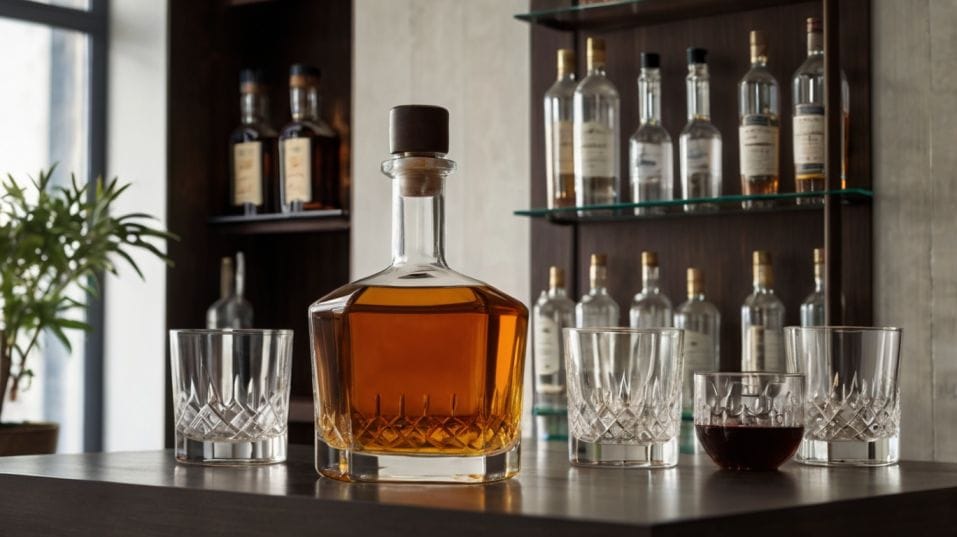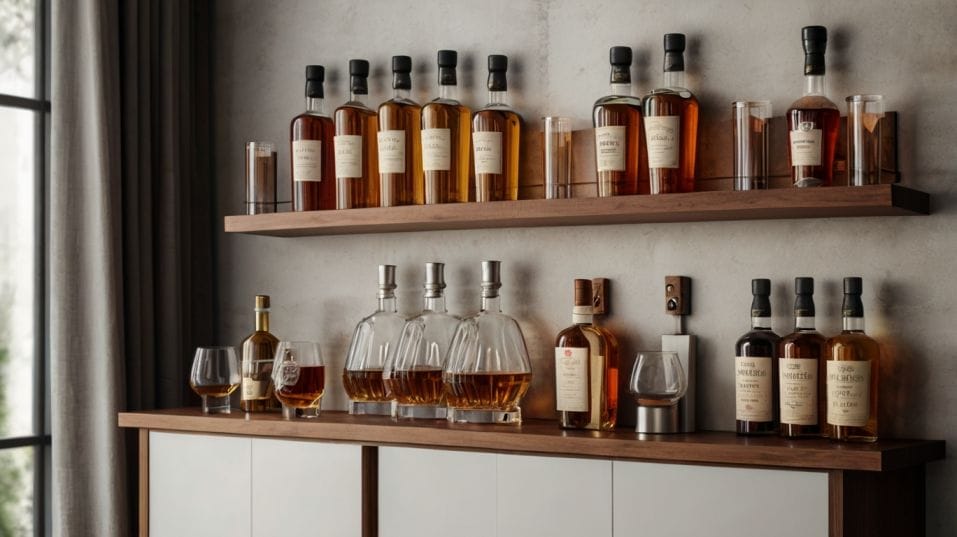DIY Whiskey Shelf: What to Know Before You Build
Thinking of building a whiskey shelf? Learn how to design one that protects your bottles, sharpens your palate, and grows with your taste.

What if your shelf could change how you taste whiskey? If you’ve started sipping with intention and collecting bottles that matter, it’s time your storage caught up.
This isn’t about showing off—it’s about creating a space that supports how you drink, learn, and explore.
A well-built whiskey shelf can sharpen your palate, protect your collection, and evolve with your taste. Before you start building, here’s what you need to know to get it right.
Build for Taste, Not Just Storage
Plenty of people build shelves based on bottle count. That’s a mistake. What matters is how you interact with your whiskey—not how many bottles you can cram onto a plank.
Whiskey collecting isn't about stockpiling. It's about selection, reflection, and taste memory. Your shelf should help you engage with the bottles, not just display them.
Ask yourself how you really drink:
- Do you rotate through a few favorite pours each week?
- Do you host tastings?
- Are you exploring specific regions or styles—American rye, Japanese single malt, unpeated Highland Scotch?
Your answers should guide your layout. A tight grid of bottles may look clean on Pinterest, but it kills context.

You’ll lose track of flavor families, production styles, and aging experiments. Design for separation. Give your bottles space.
A shelf should let you group bottles in a way that builds understanding—by region, by cask finish, by proof. The more clearly you can see the differences, the more clearly you’ll taste them.
Consider the Environment: Whiskey Isn’t Immortal
Every bottle on your shelf is still evolving—slowly, subtly, and always. How you store it influences how it holds up over time. Get this wrong, and the shelf you built to honor your whiskey becomes the reason it goes flat.
Light
Direct sunlight fades labels and breaks down flavor compounds, especially in bottles that are half-full. UV rays don’t care about your collection.
Temperature
Big swings accelerate oxidation. You don’t need cellar conditions, but you do need consistency. Avoid placing your shelf near heat vents, radiators, exterior walls, or appliances that generate warmth.
Humidity
Not usually a dealbreaker unless you’re in an extreme climate, but very dry air can shrink corks over time, inviting air into the bottle. That’s a slow death.
Ventilation
Your whiskey doesn’t need to breathe, but your space does. Shelving in small, enclosed areas like closets can build up heat and trap off-notes. Let air circulate.
Bottom line: Build where the whiskey stays cool, dark, and undisturbed. Design around protection as much as presentation.
Think Through Function: How You Use the Shelf Matters
This isn’t just a storage project—it’s a tool. You’ll interact with this shelf constantly. Pouring. Reorganizing. Sharing. Sampling blind. That means ergonomics and flow matter.
Keep everyday bottles easy to grab. Put special-occasion bottles at eye level. Don’t bury your most interesting pours behind flashy labels.
In fact, label-forward storage is overrated. When you’re tasting to learn, bottle shape and location can teach you more than a pretty label ever will.
Incorporate some utility space:
A spot for glasses, tasting journals, water droppers, maybe a decanter or two. A well-designed shelf should support your tasting ritual, not disrupt it. That means having everything close at hand—neat, purposeful, and ready for the next pour.
Even small touches like under-shelf hooks for Glencairns or a drawer for bar tools can turn a shelf from basic to brilliant.
Choose Materials That Age With You
Good whiskey gets better with time. Your shelf should, too. Wood is the classic choice for a reason. It’s warm, sturdy, and ages well. Oak, walnut, maple—these don’t just look right.
They pick up character over the years, just like your collection will. Lean into that. Avoid cheap composites or shiny finishes that scratch or warp with time. Go with something that feels grounded.
Want a cleaner, industrial vibe?
Metal framing works—but make sure it’s built to handle the weight. A single full bottle averages around 3 pounds. Do the math. A modest 25-bottle shelf could weigh over 75 pounds, plus the shelf materials themselves.
That rules out weak floating brackets or drywall anchors unless you’re hitting studs. This isn’t a spice rack. Build accordingly.
Don’t forget the finish
A whiskey shelf will see occasional drips, fingerprints, condensation from glasses. Use a stain or sealant that can take it.
Leave Room to Evolve
Your palate’s going to change. Fast. That $30 bourbon you’re loving today might feel flat a year from now when you’ve tried a few barrel-strength ryes or a cask-finished Scotch. Build a shelf that can grow with you.
That means modular thinking. Can you add more sections later? Reconfigure how bottles are spaced? Store a tall 700ml bottle next to a squat 1-liter without it looking ridiculous?
Also think vertically
A tiered setup lets you spotlight key bottles. Deeper shelves let you stage unopened bottles behind open ones. That helps with bottle rotation, aging strategy, and avoiding duplicates.
Pro tip: always write open dates on the bottle base. A good shelf makes it easy to check.
If you’re thinking of getting into serious collecting—limited releases, older age statements, even auction finds—start designing for it now. Not by leaving giant gaps, but by choosing materials and layouts that adapt.
Security, Style, and Respect
You don’t need a lockbox. But if kids are around? Guests who treat whiskey like mixer fuel? A discreet cabinet or locking mechanism goes a long way.
It’s not about paranoia—it’s about respect. For the whiskey. For the work that went into making it. For the hours you’ve spent building your palate.
Same goes for styling
A whiskey shelf isn’t supposed to be trendy. Skip the neon “Whiskey Time” signs or faux-distressed barn wood unless that actually fits your space. Let the bottles do the talking. Clean lines.
Strong materials. Purposeful design. That’s what tells people this isn’t a gimmick shelf—it’s a working part of your whiskey journey.
Final Thoughts
A great whiskey shelf does more than store. It teaches. It reminds you what you’ve learned—and what you’re still chasing. It helps you drink better, not just more. If you build it right, it becomes a space that invites attention, focus, and care.
So don’t rush it. Sketch ideas. Measure your space. Reorganize your bottles and see what you naturally reach for. Taste something tonight and ask: how would this bottle live on a shelf that really supports your curiosity?
Then build that shelf. Not for looks. Not for likes. For the whiskey—and for the drinker you're becoming.




